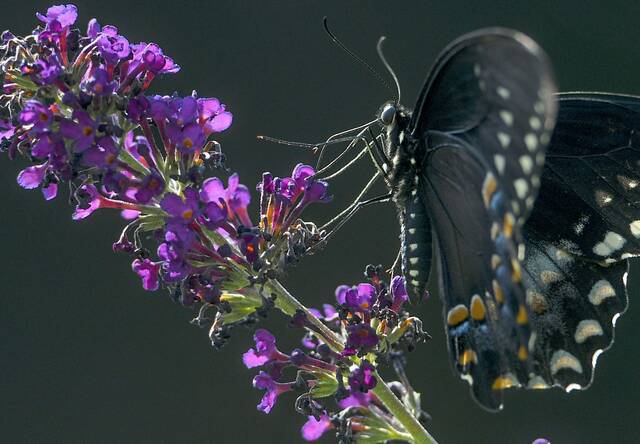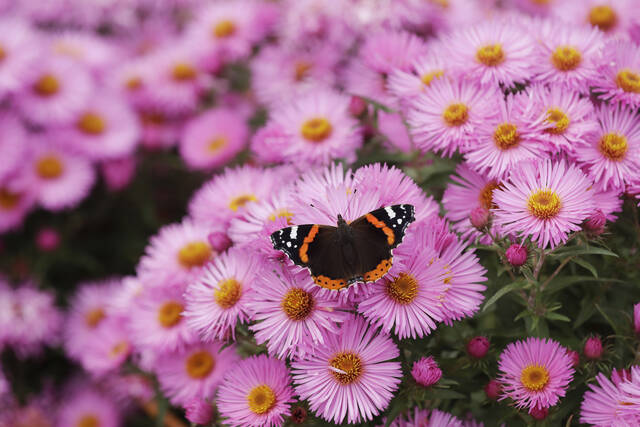Annual butterfly count will take place in Monroeville
There are more than 120 species of butterflies in Western Pennsylvania, and the North American Butterfly Association wants residents to keep an eye out for all of them at the 25th annual North American Butterfly Count, which takes place Saturday, July 12, in Monroeville.
But many common species are far less abundant than they used to be, according to Kevin Keegan, invertebrate zoology collection manager for the Carnegie Museum of Natural History in Pittsburgh.
“It’s likely owing to a variety of causes, including but not limited to habitat loss, invasive species, climate change and pesticide use,” Keegan said. “The zebra swallowtail was once far more abundant in Western Pennsylvania — especially Pittsburgh, as evidenced by specimens in the Carnegie’s collection. But it was mainly extirpated from the area, and it’s not clear why, but it was likely due to habitat loss along riverways caused by industry.”
Participants in the count will observe and collect butterflies, and the count results will be reported to the association. It will be from 9 to 11:30 a.m., and anyone interested can meet at the PPG Monroeville Business & Technology Center at 440 College Park Drive. Registration is required by visiting the website Bit.ly/3G5gqW8.
Keegan spoke with TribLive about the region’s butterfly population. This interview has been edited for length.
Q: What types of butterflies are you most likely to come across in Western Pa.?
A: There are more than 120 species of butterflies in Western Pennsylvania, so there’s a lot to see. One of the most common species of butterflies isn’t actually native to Pennsylvania but was introduced by humans from Europe or Asia: the cabbage white (Pieris rapae). It is doing well over here, eating the abundance of nonnative Brassicaceae plants humans have also introduced from Europe and Asia.
Some of our swallowtails are also quite common, like our native black swallowtail (Papilio polyxenes) and Eastern tiger swallowtail (Papilio glaucus). Various skippers and duskywings like Peck’s skipper (Polites peckius), common checkered-skipper (Burnsius communis) and Juvenal’s duskywing (Erynnis juvenalis) are likely to be encountered.
There are also many common brush-footed butterflies like the monarch (Danaus plexippus), red admiral (Vanessa atalanta), painted lady (Vanessa cardui), pearl crescent (Phyciodes tharos) and little wood satyr (Megisto cymela).
Hairstreaks like the Eastern tailed blue (Cupido comyntas) and the azures (Celastrina spp.) are also relatively easy to find.
Q: What are some types of butterflies that are only around this time of year, or that are here now when they were not in the past?
A: In general, species make their first appearances in the season much earlier due to climate change. Monarchs began appearing in my yard here in Pittsburgh a couple of weeks ago. Great spangled fritillaries (Argynnis cybele) started to appear last week. The species will peak in Western Pennsylvania towards the middle of July, like many other butterfly species here.
The eastern giant swallowtail used to be rare in the area but has expanded its range north dramatically due to climate change and is now more common here than at any point in the past, at least 10,000 years likely. Some species are now able to have two generations per growing season when in the past they could only muster one and change.
These second generations are typically in the later half of the growing season, though not now.
Q: What are some of the ways that butterflies contribute to, and help create balance within, the ecosystem?
A: Butterflies make food: They are important pollinators like bees that help flowers turn into fruits for all of the other animals — including us — to eat.
In addition, butterflies are food: One of the most important food sources in terrestrial environments is caterpillars. In particular, baby songbirds need them — their diet is almost 50% caterpillars when they are growing.
Butterflies continue to be an important food source for birds and other animals even after their caterpillar stage.
Patrick Varine is a TribLive reporter covering Delmont, Export and Murrysville. He is a Western Pennsylvania native and joined the Trib in 2010 after working as a reporter and editor with the former Dover Post Co. in Delaware. He can be reached at pvarine@triblive.com.
Remove the ads from your TribLIVE reading experience but still support the journalists who create the content with TribLIVE Ad-Free.




